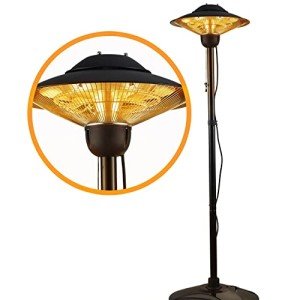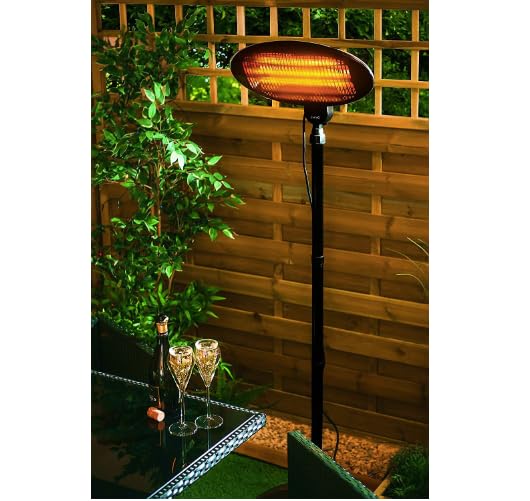Choosing a
Gas Or Electric Patio Heater
Most patio heaters use electricity or propane to power them. Electric models are simpler to use and cost less to run than propane heaters.

If you plan to use the heater for a long time it is crucial that you're near an outlet and utilize extension cords that are outdoor-rated. To prevent risk, it is essential to examine the power cord frequently for frayed areas.
How to Select the Right Heater
To ensure that the patio heater you select will be able to warm your space effectively You must take into account its BTU (boiler rating total heat output) power. This number is determined by the area you have and is therefore important to know this before selecting a model. If you're not sure what to do, a general rule of thumb is to multiply your square footage by 20, which should give you an approximate figure of the heat output you require.
Propane models are more powerful in BTUs when compared to electric models, so they are a great choice for large, well ventilated areas. Gas heaters are also more expensive to operate than electric models. This is mostly due to the expense of purchasing propane tanks and gas lines, as well as the energy costs associated with heating your heater.
You should ensure that any gas heater for outdoor use you purchase for your home has a thermocouple. This is a crucial component of any gas-powered heater because it will shut off the flame in the event that it becomes extinguished or fails to ignite. It's a simple feature that can help prevent dangerous carbon monoxide poisoning and other dangers.
When it comes time to pick an electric patio heater for your home, you'll be spoilt by the variety of designs available on the market. You can pick from wall-mounted heaters, bar-shaped models that come with their own stands or tall freestanding models. Some models are extremely elegant while others are more practical and utilitarian.
Electric
cheap patio gas heaters offer an advantage since they do not produce any emissions and can be used in
small gas patio heater spaces without the need for venting. Electric patio heaters are more affordable and easier to maintain than gas-powered ones, which makes them a great choice for homeowners who wish to minimize their impact on the environment. Many models are available in a variety of colors to complement your decor and can also be recessed into ceilings for more subtle installation.
Safety
Patio heaters aren't different. They have their own safety issues. For one, they produce lots of heat, so they need to be kept away from flammable materials such as furniture, curtains carpets, decorations and carpets. Also, they should be placed on non-flammable surfaces, such as tiles or concrete. To ensure safety, experts recommend keeping at least three feet of space around the entire perimeter of the heater.
Since they emit carbon monoxide as well as other harmful gases gas patio heaters must not be used indoors, or in any enclosed space where the gases can build up and poison occupants. Propane and natural gas patio heaters should also always be used outdoors, where there is ample ventilation to prevent the dangerous fumes from leaking into.
Electric patio heaters are the most secure of all heating options for outdoor use because they do not emit any gasses. Electric patio heaters are powered by a constant source of electricity. This is beneficial since it doesn't need refueling, or replacing cylinders or pipes. The heaters can be utilized as long as power is available. Consult your local fire department or your city's building codes to learn more about the rules and warnings that are applicable to your area when you intend to use heaters outdoors.
If you decide to go with natural-gas, propane or electric model, make sure it has a good warranty in case of issues. It's recommended to have both electric and gas models professionally inspected prior to the beginning of each season to ensure they're operating properly and not at risk for developing any safety issues during prolonged use.
Propane and natural gas patio heaters that require a cylinder will need to be replaced regularly which increases the cost of these systems. But the convenience of being able to pop a new cylinder into place is well worth the cost for many homeowners.
Installation
When it comes to the installation of your new patio heater, it is essential to leave it to professionals to handle the job. Gas (propane, natural gas) and electric systems require a huge mounted system that must be securely fixed. They also operate at higher voltages and consequently, require a lot of care when it comes to their installation.
If you're using a gas patio heater, ensure that it's always properly vented. This will stop the accumulation of carbon monoxide within your home, which could be deadly. It is also a good idea to use only approved propane tanks, and to have the propane tank refilled whenever needed. Gas patio heaters tend to be more efficient than electric models. However, they may also be less portable because propane has to be replenished often.
Installing electric heaters in a covered space can reduce the loss of heat. It will also protect the heater from inclement weather and debris that could cause damage. You may need to use an extension cable for outdoor use with your electric heater in some cases. Make sure that it is an extremely durable model that is rated for outdoor usage.
Both gas and electric patio heaters are available in various styles including freestanding models, wall-mounted versions, and ceiling-mounted ones. They can also be found in a variety of finishes and colors that fit in with your decor. Some of the most sought-after choices include brushed stainless steel as well as oil rubbed bronze and matte black.
The
Best patio heater gas way to decide which heater is the
best gas patio heater for your needs will depend on several aspects, including the heating capacity of your area, as well as the cost of energy in the region. The most important factor is safety. Be sure that the appliance you purchase comes with a built-in flame sensor which will shut off the system in the event that the flame goes out. Some models also have safety guards around the burner to prevent accidents and lower the chance of fire.
Maintenance
Whatever type of heater you pick it is important to maintain them regularly to ensure their safe and efficient operation. This is especially true for gas patio heaters which are often subject to more frequent problems than their electric counterparts because of the nature of their fuel source.
The heaters that are powered by gasoline should be inspected regularly for carbon deposits on the orifices and the pilot tube. These can inhibit combustion, resulting in reduced heat output and possibly an increase in fire risk. Additionally the thermocouple as well as the regulator need to be examined to ensure that they are in good condition. These components are to be replaced if they are needed, or repaired by an expert.
At least once per year, propane and natural gas patio heaters ought to be checked for leaks as well as other safety issues. The inspection should be carried out by an accredited professional. It also involves checking the electrical wiring for damage, which can be caused by exposure to the weather and curious animals.
Infrared patio heaters are less costly to maintain than gas-powered ones. They use radiant heating to warm people and objects instead of simply warming the air around them which is the reason they are more efficient at warming patios. They also don't have the same environmental issues as gas heaters that release greenhouse gases and carbon dioxide in the atmosphere when they are operating.
If you have a propane or natural-gas patio heater, make sure you have an extinguisher nearby and remind your guests to be cautious when they are sitting too close. Regularly cleaning the burner screen and dome of your patio heater is crucial to get rid of dust and other debris. If you notice a buildup of carbon, which can hinder the flame, you may require replacing the element or igniter.
Verify that the hose is securely attached to the regulator every time you change your gas bottle. The jubilee clip should be secured and there should not be any movement between the two pieces. Every now and then, you must give the hose a "soap-test" to ensure it is not leaky.

 Most patio heaters use electricity or propane to power them. Electric models are simpler to use and cost less to run than propane heaters.
Most patio heaters use electricity or propane to power them. Electric models are simpler to use and cost less to run than propane heaters. If you plan to use the heater for a long time it is crucial that you're near an outlet and utilize extension cords that are outdoor-rated. To prevent risk, it is essential to examine the power cord frequently for frayed areas.
If you plan to use the heater for a long time it is crucial that you're near an outlet and utilize extension cords that are outdoor-rated. To prevent risk, it is essential to examine the power cord frequently for frayed areas.